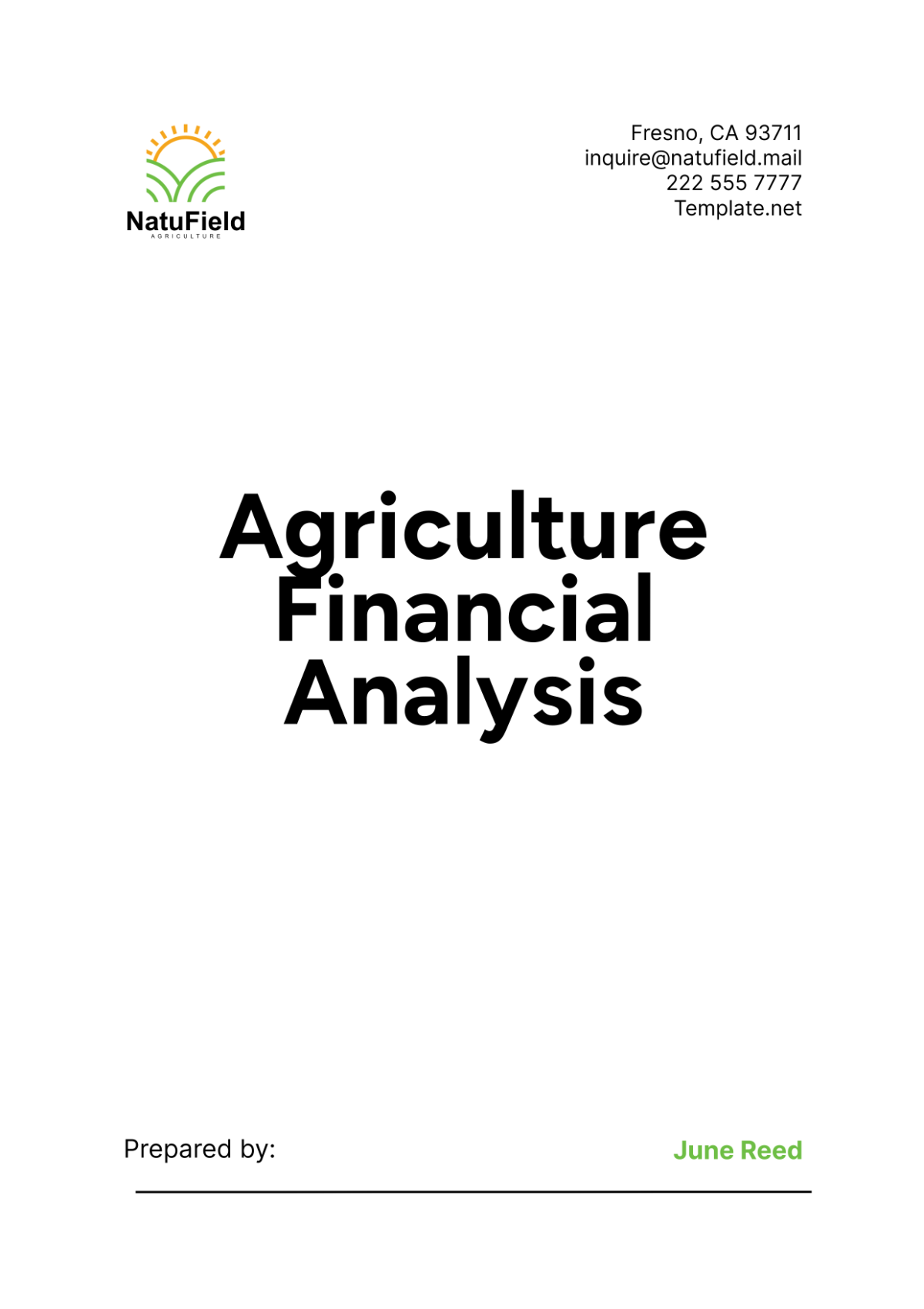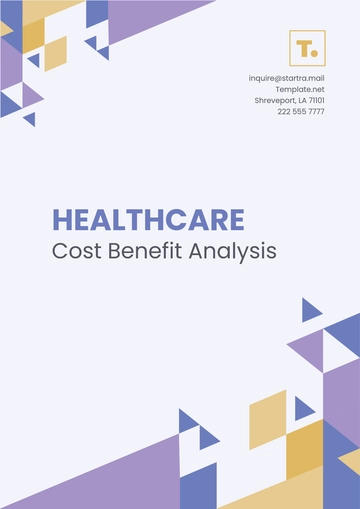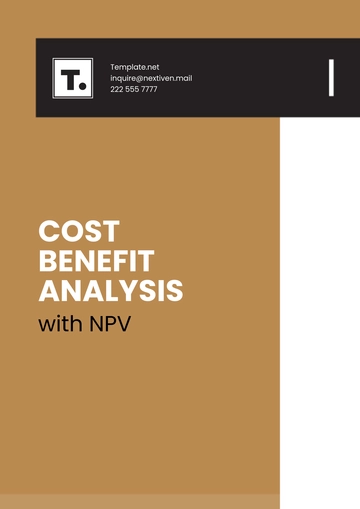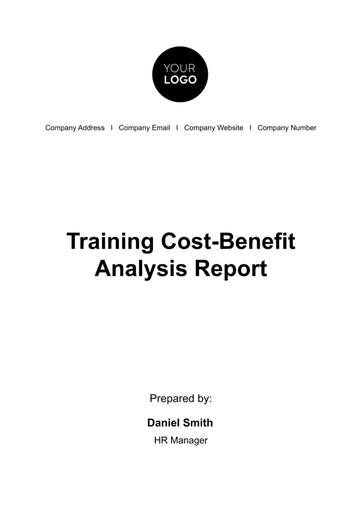Free Agriculture Financial Analysis

1. Introduction
Purpose of the Report
The purpose of this Agriculture Financial Analysis Report is to provide a comprehensive assessment of the financial health and performance of [Your Company Name] for the fiscal year ending December 31, 2050. This report aims to assist stakeholders, including management, investors, and creditors, in making informed decisions based on detailed financial data and analysis.
Scope
This report covers key financial aspects of [Your Company Name], providing a comprehensive evaluation of the company's financial health and performance over the fiscal year ending December 31, 2050. The detailed analysis is designed to assist stakeholders, including management, investors, and creditors, in making informed decisions. The scope of this report includes the following areas:
Revenue Analysis
Revenue is a crucial indicator of financial performance. This section dissects the various revenue streams of [Your Company Name], identifying major contributors and trends. By examining the distribution of revenue from different sources such as crop sales, livestock sales, agricultural services, government subsidies, and other income, stakeholders can understand which areas drive the most value and which may require strategic adjustments.
Expense Analysis
A thorough understanding of expenses is essential for effective cost management. This section categorizes and analyzes the major expenses incurred by the company, such as labor costs, raw materials, equipment maintenance, utilities, marketing, and other operational expenses. By breaking down these costs, the report aims to highlight areas where efficiency improvements can be made and cost-saving measures can be implemented.
Profitability Assessment
Assessing profitability involves examining both gross and net profit margins. The gross profit margin reveals the percentage of revenue that exceeds the cost of goods sold (COGS), indicating how efficiently the company manages its production costs. The net profit margin reflects the overall profitability after accounting for all operating expenses, providing a clear picture of the company’s bottom line. This section helps stakeholders evaluate the company's financial success and sustainability.
Cash Flow Analysis
Cash flow is the lifeblood of any business. This section provides a detailed examination of cash flows from operations, investing activities, and financing activities. Cash flow from operations indicates the company's ability to generate cash from its core activities, while cash flow from investing activities examines the purchase and sale of long-term assets. Cash flow from financing activities looks at debt and equity financing. Understanding these cash flows is crucial for assessing the company’s liquidity and operational efficiency.
Financial Ratios
Financial ratios are critical for evaluating the company's financial health and performance. This section covers liquidity ratios, solvency ratios, and profitability ratios. Liquidity ratios measure the company's ability to meet short-term obligations, solvency ratios assess long-term financial stability, and profitability ratios evaluate the company's ability to generate profit. These ratios provide a comprehensive view of the company’s financial stability and operational efficiency.
Investment Analysis
Investments in long-term assets are vital for the growth and sustainability of agricultural operations. This section examines the capital expenditures made by [Your Company Name], such as investments in new irrigation systems and advanced machinery. By calculating the return on investment (ROI) for these expenditures, the report evaluates the effectiveness and efficiency of the company’s investment decisions. This analysis helps stakeholders understand how well the company is utilizing its resources to generate returns.
Conclusion and Recommendations
Based on the comprehensive analysis, the report concludes with a summary of key findings and actionable recommendations. These recommendations aim to enhance financial performance, optimize costs, expand revenue streams, and strengthen financial management practices. By implementing these strategies, [Your Company Name] can continue to thrive in the competitive agricultural sector, ensuring sustainable growth and profitability.
Additional Considerations
The scope of this report is designed to be comprehensive yet focused, providing relevant insights without overwhelming stakeholders with unnecessary details. Each section is crafted to offer clear, actionable information supported by relevant data and metrics, ensuring that the analysis is both practical and informative. This approach ensures that the report is a valuable tool for strategic decision-making and long-term planning.
2. Financial Overview
The financial overview section provides a detailed examination of [Your Company Name]'s revenue and expense structures. Understanding these fundamental components is crucial for assessing the company’s financial stability and identifying areas for potential improvement. This section highlights the major revenue streams and expense categories, offering insights into their contributions to the overall financial performance.
Revenue Analysis
Revenue is a critical indicator of the financial performance of [Your Company Name]. This section provides an analysis of revenue streams, highlighting major contributors and trends.
Revenue Stream | Amount ($) | Percentage of Total Revenue (%) |
|---|---|---|
Crop Sales | 5,000,000 | 50 |
Livestock Sales | 2,500,000 | 25 |
Agricultural Services | 1,500,000 | 15 |
Government Subsidies | 500,000 | 5 |
Other Income | 500,000 | 5 |
Total Revenue | 10,000,000 | 100 |
Key Observations
Crop Sales: Crop sales remain the largest revenue stream, contributing 50% of the total revenue.
Livestock Sales: Livestock sales account for 25%, reflecting significant diversification.
Agricultural Services and Government Subsidies: These also provide substantial contributions, enhancing revenue stability.
Expense Analysis
Understanding the expense structure is crucial for effective cost management. This section breaks down the major expenses incurred by [Your Company Name].
Expense Category | Amount ($) | Percentage of Total Expenses (%) |
|---|---|---|
Labor Costs | 2,000,000 | 25 |
Raw Materials | 3,000,000 | 37.5 |
Equipment Maintenance | 1,000,000 | 12.5 |
Utilities | 500,000 | 6.25 |
Marketing and Sales | 1,000,000 | 12.5 |
Other Expenses | 500,000 | 6.25 |
Total Expenses | 8,000,000 | 100 |
Key Observations
Raw Materials: Raw materials are the largest expense category, representing 37.5% of total expenses.
Labor Costs: Labor costs are significant at 25%, underscoring the importance of human resources in agricultural operations.
Equipment Maintenance and Marketing: These expenses are also notable, reflecting the need for ongoing investment in operations and market reach.
3. Profitability Assessment
Assessing profitability is essential for understanding the financial success and sustainability of [Your Company Name]. This chapter examines the gross and net profit margins, which indicate the efficiency of cost management and the overall profitability of the company.
Gross Profit Margin
The gross profit margin indicates the percentage of revenue that exceeds the cost of goods sold (COGS).
Metric | Amount ($) | Percentage (%) |
|---|---|---|
Total Revenue | 10,000,000 | 100 |
COGS | 4,500,000 | 45 |
Gross Profit | 5,500,000 | 55 |
Net Profit Margin
The net profit margin reflects the overall profitability after all expenses are deducted from total revenue.
Metric | Amount ($) | Percentage (%) |
|---|---|---|
Total Revenue | 10,000,000 | 100 |
Total Expenses | 8,000,000 | 80 |
Net Profit | 2,000,000 | 20 |
Key Observations
Gross Profit Margin: The gross profit margin of 55% indicates strong efficiency in managing production costs.
Net Profit Margin: The net profit margin of 20% reflects healthy profitability after accounting for all operating expenses.
4. Cash Flow Analysis
Cash flow analysis is critical for understanding the liquidity and operational efficiency of [Your Company Name]. This chapter examines the cash flows from operations, investing activities, and financing activities, providing insights into the company’s ability to generate and manage cash.
Cash Flow from Operations
Cash flow from operations is a key indicator of the company’s ability to generate cash from its core activities.
Metric | Amount ($) |
|---|---|
Net Income | 2,000,000 |
Depreciation | 500,000 |
Changes in Working Capital | 300,000 |
Net Cash from Operations | 2,800,000 |
Cash Flow from Investing Activities
This section examines cash flows related to the purchase and sale of long-term assets.
Metric | Amount ($) |
|---|---|
Purchase of Equipment | (1,000,000) |
Sale of Old Equipment | 200,000 |
Net Cash from Investing Activities | (800,000) |
Cash Flow from Financing Activities
This section looks at cash flows related to debt and equity financing.
Metric | Amount ($) |
|---|---|
Issuance of Shares | 500,000 |
Repayment of Loans | (300,000) |
Dividends Paid | (200,000) |
Net Cash from Financing Activities | 0 |
Key Observations
Net Cash from Operations: Net cash from operations is strong, indicating effective management of operational cash flows.
Investment in Equipment: Investment in new equipment highlights ongoing capital expenditure to support growth.
Balanced Financing Activities: Financing activities are balanced, with new equity issuance offsetting debt repayments and dividends.
5. Financial Ratios
Financial ratios provide valuable insights into the financial health and performance of [Your Company Name]. This chapter examines liquidity, solvency, and profitability ratios, offering a comprehensive evaluation of the company's financial stability and efficiency.
Liquidity Ratios
These ratios measure the company's ability to meet short-term obligations.
Ratio | Formula | Value |
|---|---|---|
Current Ratio | Current Assets / Current Liabilities | 2.5 |
Quick Ratio | (Current Assets - Inventory) / Current Liabilities | 1.8 |
Solvency Ratios
These ratios assess the company’s long-term financial stability.
Ratio | Formula | Value |
|---|---|---|
Debt-to-Equity Ratio | Total Debt / Total Equity | 0.5 |
Interest Coverage Ratio | EBIT / Interest Expense | 6 |
Profitability Ratios
These ratios evaluate the company's ability to generate profit.
Ratio | Formula | Value |
|---|---|---|
Return on Assets (ROA) | Net Income / Total Assets | 10% |
Return on Equity (ROE) | Net Income / Total Equity | 15% |
Key Observations
Liquidity Ratios: The current and quick ratios indicate strong liquidity.
Solvency Ratios: Solvency ratios suggest a conservative approach to debt, with substantial equity backing.
Profitability Ratios: Profitability ratios demonstrate effective utilization of assets and equity to generate returns.
6. Investment Analysis
Investment analysis is crucial for understanding the allocation of capital and the returns on investments. This chapter examines the capital expenditures of [Your Company Name], providing insights into the effectiveness and efficiency of these investments.
Capital Expenditure
This section examines the company’s investments in long-term assets.
Investment Item | Amount ($) | Purpose |
|---|---|---|
New Irrigation Systems | 600,000 | Improve water efficiency |
Advanced Machinery | 400,000 | Enhance production capacity |
Return on Investment (ROI)
Calculating ROI helps evaluate the effectiveness of capital investments.
Investment Item | Net Gain ($) | Investment ($) | ROI (%) |
|---|---|---|---|
New Irrigation Systems | 900,000 | 600,000 | 50 |
Advanced Machinery | 600,000 | 400,000 | 50 |
Key Observations
High ROI: Investments in irrigation systems and machinery are yielding high returns, indicating sound investment decisions.
Continued Focus on Capital Expenditures: Continued focus on capital expenditures can enhance operational efficiency and productivity.
7. Conclusion and Recommendations
Summary of Findings
The financial analysis of [Your Company Name] for the year 2050 reveals a robust financial position characterized by:
Strong revenue generation with diversified income streams.
Effective cost management resulting in healthy profit margins.
Positive cash flows from operations supporting ongoing capital investments.
Solid liquidity and solvency ratios ensuring financial stability.
Recommendations
To maintain and enhance financial performance, the following comprehensive recommendations are made:
1. Expand Revenue Streams
Expanding revenue streams is critical for enhancing financial stability and fostering growth. [Your Company Name] should consider exploring new markets and product lines to diversify its income sources. This could involve:
Entering New Geographic Markets: Identify and target untapped regions where demand for agricultural products is high. Conduct market research to understand local consumer preferences and tailor products accordingly.
Developing New Product Lines: Innovate and introduce new products that align with current market trends. For example, consider organic produce, value-added products (such as canned or packaged goods), or specialty crops that command higher market prices.
Leveraging Technology: Utilize e-commerce platforms to reach a broader customer base. Establish an online presence to sell products directly to consumers, which can also help gather valuable customer data for future marketing strategies.
Exploring Export Opportunities: Investigate the potential for exporting products to international markets. This can diversify revenue streams and reduce dependence on domestic markets.
Establishing Strategic Partnerships: Partner with other companies or agricultural cooperatives to share resources and access new markets. Joint ventures can also provide opportunities for cross-selling products.
2. Cost Optimization
Effective cost management is essential for maintaining profitability. [Your Company Name] should implement advanced technologies and best practices to reduce production costs without compromising quality. Consider the following strategies:
Automating Processes: Invest in automation technology to streamline operations. Automated irrigation systems, drones for crop monitoring, and automated feeding systems for livestock can significantly reduce labor costs and increase efficiency.
Adopting Precision Agriculture: Utilize precision agriculture techniques to optimize resource use. Technologies such as GPS-guided equipment, soil sensors, and satellite imagery can help apply inputs like water, fertilizers, and pesticides more accurately, reducing waste and costs.
Bulk Purchasing: Negotiate bulk purchasing agreements for raw materials and supplies. Buying in larger quantities can secure discounts and lower per-unit costs.
Energy Efficiency: Implement energy-saving measures to reduce utility costs. Consider using renewable energy sources, such as solar panels, and upgrading to energy-efficient equipment.
Lean Management Practices: Adopt lean management principles to identify and eliminate waste in processes. Continuous improvement initiatives can help streamline operations and reduce unnecessary expenses.
Regular Maintenance: Implement a proactive maintenance schedule for equipment to prevent costly breakdowns and extend the lifespan of machinery.
3. Investment in Sustainability
Sustainability is not only environmentally responsible but also economically beneficial in the long run. Increasing investments in sustainable practices can improve [Your Company Name]'s market positioning and profitability. Consider these sustainable practices:
Soil Health Management: Invest in practices that enhance soil health, such as crop rotation, cover cropping, and organic fertilizers. Healthy soil improves crop yields and reduces the need for chemical inputs.
Water Conservation: Implement water-saving technologies like drip irrigation and rainwater harvesting. Efficient water use reduces costs and ensures compliance with environmental regulations.
Renewable Energy: Transition to renewable energy sources such as solar or wind power. This not only reduces energy costs but also enhances the company's reputation as a sustainable business.
Waste Reduction: Develop systems to recycle agricultural waste, such as turning crop residues into compost or bioenergy. Reducing waste lowers disposal costs and creates additional revenue streams.
Sustainable Certifications: Obtain certifications such as organic, Fair Trade, or Global GAP (Good Agricultural Practices). These certifications can open new market opportunities and allow the company to charge premium prices.
Community Engagement: Engage with local communities through sustainable practices. Supporting local initiatives and sourcing locally can enhance the company's social license to operate.
4. Strengthen Financial Management
Strong financial management is crucial for anticipating and mitigating risks. [Your Company Name] should continue rigorous financial monitoring and analysis to maintain financial health. Consider these strategies:
Regular Financial Audits: Conduct regular internal and external financial audits to ensure accuracy and transparency in financial reporting. Audits help identify discrepancies and areas for improvement.
Robust Financial Planning: Develop detailed financial plans that include budgets, forecasts, and scenario analyses. Planning helps anticipate potential financial challenges and prepare contingency measures.
Risk Management: Implement a comprehensive risk management framework to identify, assess, and mitigate financial risks. This includes market risks, operational risks, and credit risks.
Cash Flow Management: Monitor cash flow closely to ensure liquidity. Implement strategies to improve cash flow, such as optimizing inventory levels and negotiating favorable payment terms with suppliers and customers.
Debt Management: Maintain a healthy debt-to-equity ratio by managing borrowing effectively. Avoid over-leveraging and ensure that debt levels are sustainable.
Training and Development: Invest in financial training for management and staff. Ensuring that the team is knowledgeable about financial best practices and tools enhances overall financial management capabilities.
Technology Integration: Utilize financial management software to streamline accounting processes, improve data accuracy, and provide real-time financial insights.
By implementing these strategies, [Your Company Name] can enhance its financial performance, ensuring sustainable growth and profitability. These recommendations provide a comprehensive approach to managing and improving financial health, positioning the company for long-term success in the competitive agricultural sector.
- 100% Customizable, free editor
- Access 1 Million+ Templates, photo’s & graphics
- Download or share as a template
- Click and replace photos, graphics, text, backgrounds
- Resize, crop, AI write & more
- Access advanced editor
Streamline your farm's financial oversight with Template.net's Agriculture Financial Analysis Template. This comprehensive tool is fully editable and customizable using our AI editor, designed to help you assess financial performance, identify trends, and make informed decisions. Perfect for farmers aiming to optimize profitability and ensure financial health in the competitive agricultural sector.





























